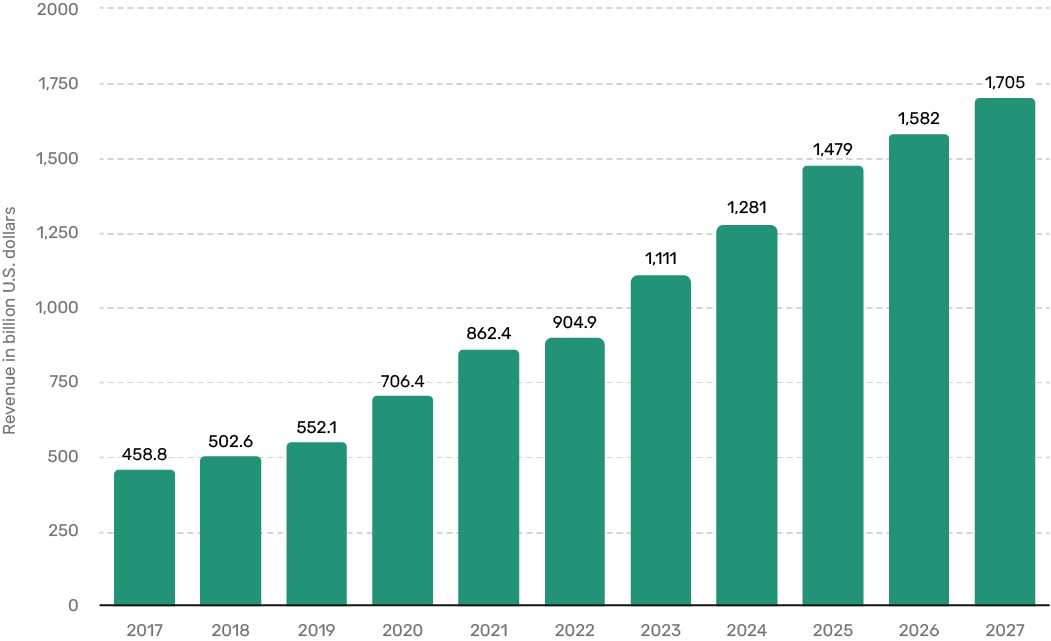In this age of digital transformation, simply selling goods is not enough to drive sales and profitability. Today, customers expect accessibility and variety, which has brought digital commerce to the forefront. Businesses expect supply chains to drive topline growth and creating a singular customer experience is one way to do that. A study by Gartner says that enabled customers are 2x more likely to repurchase, yet only 23 percent of the supply chains are focused on customer enablement.
With a volatile business environment, several businesses are adopting a customer-focused approach and making investments in the right technology, people, and processes to take digital commerce to the next level. Though most companies do tick every box to make the consumer-focused aspects of online commerce growth successful, few realize that optimizing digital commerce also means optimizing their supply chain.
Did you know that earnings from retail eCommerce in the US were projected at nearly $1,111 billion in 2023? Here is the graphical representation of eCommerce earnings in the US during the period 2017-2027.
According to McKinsey, businesses that assertively digitize their supply chain expect to increase their yearly revenue growth by 3.2%, before taxes and interest.
The digital commerce sector has witnessed improvement for several years now, however, the pandemic led to a significant and sudden rise in the demand for online products. Amidst sluggish economies even during the post-pandemic times, the increased demand for online products as well as digital transformation has been extreme. A recent report says that eCommerce sales in the US during 2020-2021 were $219 billion. As an online store owner with a good digital presence, you may have seen decent sales in the last few years, but do you face these common challenges?
In the post-pandemic world, eCommerce has become a robust channel for significant sales and expansion. Exploiting this opportunity calls for reimagining a company’s total sales as well as distribution tactics, especially supply chain optimization. So, here is how you can reinforce the same:
Intelligent Supply Chain: Making the most of technologies including artificial intelligence and machine learning, automation, and analytics will help you gain the required control and visibility of your supply chain, and continuously improve and remove waste.
Automation: Your business needs automation to optimize your supply chain network for meeting changing customer demands. Use automation as a foundational technology for your supply chain optimization processes and warehouse systems to accelerate deliveries and minimize margin for error.
Cloud: Leveraging cloud tools as well as systems will reinforce and optimize your supply chain to ensure unparalleled elasticity and scalability. As cloud-based systems develop when your products’ demand grows, expect to push customer satisfaction and outshine your competitors.
Integrated Management Software: Instead of relying on distinct tools and systems to manage your supply chain optimization network, it makes sense to opt for supply chain optimization services that provides the visibility you need into supply chain operations: right from when your products will be delivered to how you can effectively manage returns and replacements and deal with the problems your fleet is facing.
Rather than relying on different systems to manage your supply chain, capitalize on integrated management software. You will have visibility into your supply chain operations, be it:
Smooth Integration between Systems and Departments: Integrated planning throughout your business’s functional areas will help in lining up supply with product demand, improving stock investment, and achieving a better return on investment.
Customer Sentiment: Understand customer behavior and sentiment to improve your supply chain optimization. Capture information from various sources to predict demand efficiently. Curate plans and adjust business processes to meet the required demands and flawlessly handle your stock in today’s complex, worldwide retail ecosystem.
Artificial Intelligence, the cloud, and the Internet of Things are trending. The International Data Corporation (IDC) predicted that there will be double-digit yearly growth in worldwide IoT expenditure in the year 2022. The next-gen supply chain optimization trends would be backed by innovative technologies such as AI and ML, IoT, Augmented Reality (AR), and Robotic Process Automation (RPA). IDC also mentions that 65 percent of warehouse activities will be employing situational data analytics and robots by this year. It will help in storage optimization, growth in warehouse capacity by over 20 percent, and reduced work order processing by 50 percent.
In the days to come, businesses will discover unique ways for supporting their entire supply chain management, implementation, data analysis, and predictive analysis. AI and ML, cloud, IoT, and AR are likely to help identify patterns, inaccuracies, and rectify supply chain challenges, and that too in real-time.






